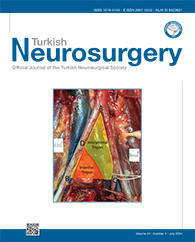2Asan Medical Center, University of Ulsan College of Medicine, Department of Neurosurgery, Seoul, South Korea
3University of Ulsan College of Medicine, Gangneung Asan Hospital, Department of Emergency Medicine,Gangneung, Korea
4Korea University Medicine, Department of Neurosurgery, Seoul, South Korea DOI : 10.5137/1019-5149.JTN.44294-23.3 AIM: To compare the clinical and radiological results of patients who underwent multilevel posterior cervical fusion (PCF) with different end levels (C6 or C7).
MATERIAL and METHODS: We collected radiographs and clinical results of all subjects who underwent 3 level or more PCF for degenerative disease from May 2012 to December 2020. Based on the location of the end of fusion during surgery, patients were divided into C6 (group 1) and C7 patients (group 2). The clinical and radiological results of both groups were compared over two years.
RESULTS: A total of 52 patients met the inclusion criteria of this study (21 in group 1 and 31 in group 2). The clinical results demonstrated a statistically significant difference with respect to a lower neck visual analog scale score in group 1 than in group 2 at the last follow-up (p=0.03). With regard to the radiological results, the C2?C7 sagittal vertical axis showed significantly greater values in group 2 than in group 1 at the final follow-up (p=0.02). For thoracic kyphosis (TK), group 2 had lower TK values than group 1 (p=0.03), and the T9 spinopelvic inclination was significantly greater in group 2 than in group 1 (p=0.01).
CONCLUSION: In this study, aggravation of cervical kyphosis and neck pain was observed when C7 was included in multilevel PCF surgery. The inclusion of C7 also affected the thoracolumbar parameters and global spine alignment.
Keywords : Cervical spine, Extended fusion, C7, C6, Spinal curvatures, Spinal fusion




